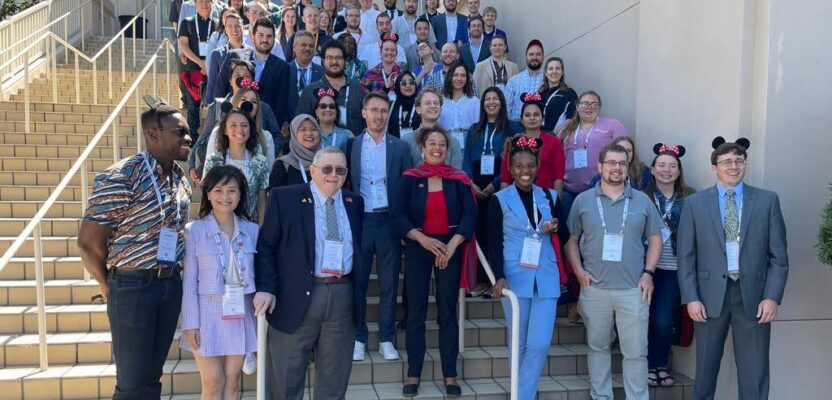Surveyor’s Corner
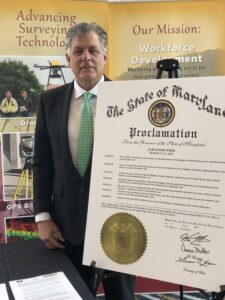
Maryland Surveying Society president Rob Kundrick. (Courtesy MSS)
In collecting thoughts and observations for this article about the future of surveying, many of my colleagues and contemporaries offered words of condolences and sadness for the profession. It is often shared with me that we are a dying line of work because technology is allowing those without education or experience to do what we do. They add they feel the surveying profession has “sold out” to the GIS, engineering, and construction communities.
I could not agree less. On the contrary, this article is about a rebirth of the profession, and it should not include a eulogy for the profession. With the environmental noise that surrounds us in our daily lives, we may not recognize the signs. The surveying profession is rising from the ashes like the mythical phoenix. How do we know this? Let’s look at the evidence around us and (hopefully) you will draw the same conclusion.
Activity at NSPS
As the executive director for the National Society of Professional Surveyors (NSPS), I oversee the operations of the association. Since beginning this position in January 2022 (and with the profession still recovering from the pandemic), I have been sitting in the front row to see how much the surveying profession is evolving and growing.
Among my responsibilities is oversight of the certification and educational programs we administer, including the Certified Survey Technician (CST) and Trig-Star programs, as well as keeping tabs on the number of materials we send out for career fairs and school visits. We have seen significant growth in interest in our programs and volume of information sent to events for promotion, so it has kept the NSPS staff quite busy keeping up with demand.
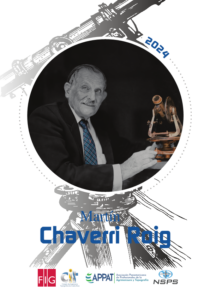
2024 Global Surveyor of the Year Martin Chaverri Ruig. (Courtesy CLGE & APPAT)
Public Awareness
In 1984, Congress passed legislation that was then signed by President Ronald Reagan to designate the third week of March as “National Surveyors Week” to honor and promote our beloved profession. In addition, NSPS, in conjunction with the International Federation of Surveyors (FIG) and the Council of European Geodetic Surveyors (CLGE), agreed to host “Global Surveyors Day” annually on March 21 to honor a significant figure from our storied past.
These events have grown significantly post-pandemic with more professional interaction at many governmental levels, including state, county, municipal, and township agencies. Official proclamations and photo ops are still coming into the NSPS office from various gatherings, so we are optimistic our practitioners’ efforts in 2025 will be even bigger.
What some may see as negative exposure for surveying is the increase in legislative actions against licensure for the profession. However, NSPS sees it as an opportunity to educate not just the legislators but the public about the importance of educated and trained professionals performing surveying tasks.
While it does take time to engage in productive conversations about our profession, we cannot overlook the opportunity to explain the necessity of having professionals performing our important work. Would you rather have an opportunity to discuss our importance or have politicians simply bypass us altogether?
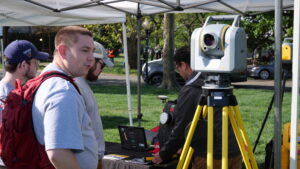
Students at USAGE booth during NSPS 2024 student competition. (Photo by NSPS)
Increasing Educational Opportunities and Enrollment
While the topic of requiring formal education for licensure is still greatly debated among our ranks, we cannot deny the fact that more surveying personnel, new and existing, are enrolling in a variety of programs nationwide and beyond.
Besides the stereotypical two- and four-year college programs, there are a growing number of vocational and technical schools now offering a variety of surveying classes covering a wide range of topics. We are also seeing the introduction of surveying curriculum in high school vocational programs, with some offering the CST Level 1 exam within the course to further signify the importance of the profession as a career.
Overall, the educational programs have seen a significant increase in enrollment, and it does not look like any drastic changes are ahead of us. The one big factor that could hold back the demand for educational programs will be the availability of instructors and teachers. If you’re a surveyor interested in doing your part to “pay it forward,” check out your local schools and see how you can apply.
A Bright Future as a Geospatialist
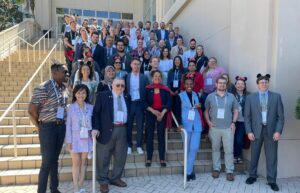
Young Surveyors Network at FIG Working Week 2023 in Orlando, Florida. (Photo by NSPS)
While some of our “seasoned” practitioners may bristle at the term geospatialist, the rise in influence of technological-based location establishment has made almost all surveyors rely on being a geolocation expert. Our cars, phones, and other tracking devices all rely on georeferenced locations and the surveying profession is no different.
We have an opportunity to implement the high-tech world of geospatial data location with the expertise of ground-based surveying principles and to merge these into an environment of a recession-proof career. The younger generations have already embraced the digital world so let’s work together to make them aware of a great career that utilizes the tools they have come to enjoy.
We all want to have a secure future in this crazy world, so why not pick a profession one can enjoy? Surveyors always have, even before the high-tech equipment was here. It’s a great day (and future) for surveyors.

